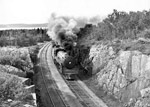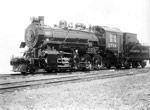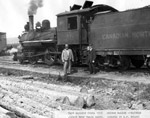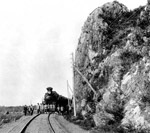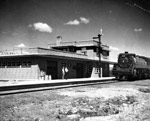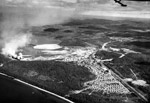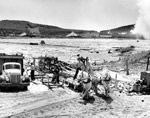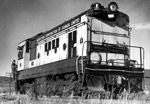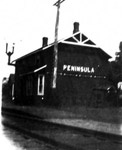Results
- Eastbound CPR train #8 passing through rock cut near Rossport, OntarioEastbound CPR train #8 passing through rock cut near Rossport, Ontario
- A comment from Bobby Timson relates the following clarification regarding this photograph: "While Boston & Maine's #3718 was named "Ye Salem Witch". This photo is not of that locomotive. The B&M locoA comment from Bobby Timson relates the following clarification regarding this photograph: …
- Cover of an actual schedule from Canadian National Railways, August 1929. This timetable shows local departure and arrival times across Canada and the Western region. Mileage was 11,345 miles. The whCover of an actual schedule from Canadian National Railways, August 1929. This …
- Canadian National Railway ticket issued to Mrs. Marander to take the train to market twice per month, from the stop at Wolfe to Fort William in 1938.Canadian National Railway ticket issued to Mrs. Marander to take the train …
- Johnny Hume (right) train agent and George McLeod (left) engineer. Johnny Hume was remembered for his unfailing kindness. George McLeod delighted onlookers with the theatrical show he put on when heJohnny Hume (right) train agent and George McLeod (left) engineer. Johnny Hume …
- With 65 engines, Canadian Pacific owned the second largest North American fleet. The first, delivered in 1929, were standard engines, but beginning in 1937 they were streamlined and used primarily foWith 65 engines, Canadian Pacific owned the second largest North American fleet. …
- CPR archives lists this photo simply as 'Historic North Shore: Lake Superior District, Ontario' It is speculated that the men in this photo could be returning from the west, where they fought in theCPR archives lists this photo simply as 'Historic North Shore: Lake Superior …
- The Marathon Station opened for business June 3, 1946 before it was even completed. Until 1953 when the western section of the Trans Canada Highway was finally opened, the only way in or out of MaratThe Marathon Station opened for business June 3, 1946 before it was …
- Located approximately 15 miles west of Marathon, this view is looking east towards the town. As faithful passengers on the Canadian, one of the highlights of each trip was going through the tunnels,Located approximately 15 miles west of Marathon, this view is looking east …
- The CPR tracks often defined the boundaries of many communities in Northwestern Ontario. In Marathon, the rail line formed the eastern most boundary from 1944 until about 1954, when new subdivisionsThe CPR tracks often defined the boundaries of many communities in Northwestern …
- A view of a rail tie sawmill at Peninsula Harbour in Marathon, Ontario. A company from Nipigon would arrive by train with their horses in time for the spring rafting season. They would set up their sA view of a rail tie sawmill at Peninsula Harbour in Marathon, …
- Proof of Rainy River's importance as a major lumbering center in the early 1900's is evident from this photo. Thousands of board feet of lumber are piled and ready for shipment to far off markets.Proof of Rainy River's importance as a major lumbering center in the …
- Aerial view of Rainy River showing its importance as a major lumbering center as early as 1900. Rainy River was the mid point transfer for shipment of grain from the west and lumber to the east, forAerial view of Rainy River showing its importance as a major lumbering …
- A train steams into the Heron Bay Station on a crisp winter day. This station burned down in 1953 and a new station was built across the road, near the present day McCuaig General Store. The second sA train steams into the Heron Bay Station on a crisp winter …
- December 5, 1949 created quite a stir for Marathonians, when the CPR showed off the new General Motors Diesel Ltd. locomotives that would shortly be replacing the old steam locomotives. That day, numDecember 5, 1949 created quite a stir for Marathonians, when the CPR …
- View shows the CPR rail line 'snaking' its way along the shore. The mill's switching rail line (left) meets the mainline. Boxcars awaiting delivery to the mill or to be picked up by freight trains. AView shows the CPR rail line 'snaking' its way along the shore. …
- An unidentified employee beside a switching diesel which was used to move box cars full of pulp bales and tanker cars from the CPR mainline, down to the mill yard. The first switching locomotive thatAn unidentified employee beside a switching diesel which was used to move …
- With the end of World War II, the men returning from the war, the men who were released from POW camps, and Europeans wishing to stay in Canada, were all well received by the town of Marathon. In thiWith the end of World War II, the men returning from the …
- The bustling town of Peninsula in 1884. This was the first landing used in the construction of the CPR. Peninsula was known as 'the wickedest city in America'. Supplies carried by steamers, such as tThe bustling town of Peninsula in 1884. This was the first landing …
- A view of Peninsula station, and tracks. Peninsula was once a popular location for painters and fishermen. Once booming, the CPR Peninsula was later reduced to the status of a siding. The ruins of thA view of Peninsula station, and tracks. Peninsula was once a popular …





